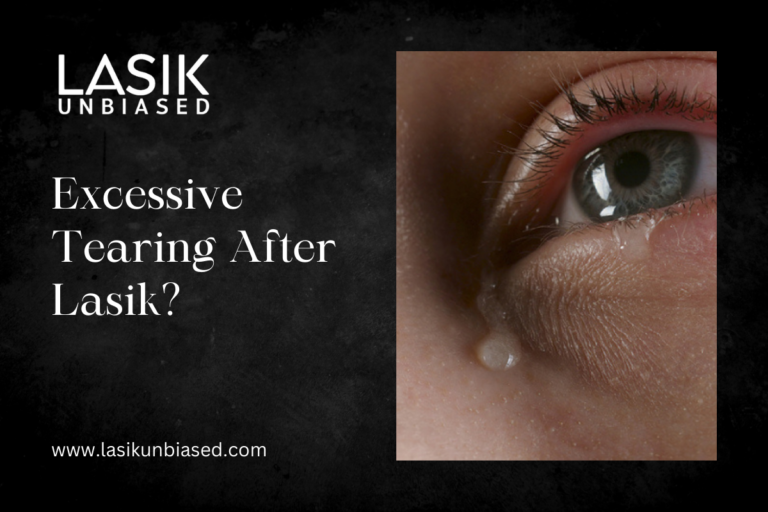LASIK surgery is a widely performed vision correction procedure that helps individuals reduce or eliminate their dependence on glasses or contact lenses. While the surgery is generally safe and effective, some patients experience excessive tearing after the procedure.
Although tearing is a natural response to surgery, persistent or excessive tearing can be uncomfortable and may indicate an underlying issue. Understanding why this happens and how to manage it can help patients recover smoothly and maintain long-term eye health.
Why Does Excessive Tearing Occur After LASIK?
Tearing, also known as epiphora, is a common post-LASIK symptom that usually resolves independently. Several factors contribute to excessive tearing in the weeks or months following the surgery.
1. Temporary Dry Eye Syndrome
Paradoxically, excessive tearing can be a sign of dry eye syndrome, a frequent side effect of LASIK. The corneal nerves are temporarily disrupted during the procedure, reducing the eye’s ability to sense dryness and regulate tear production properly. As a result, the eyes may overproduce tears to compensate for the dryness.
2. Post-Surgical Inflammation
After LASIK, the cornea is healing, and mild inflammation is common. This inflammation can irritate the tear glands, triggering excessive tear production. The body produces more tears as a protective mechanism to flush out irritants and promote healing.
3. Reflex Tearing from Light Sensitivity
Many patients experience temporary light sensitivity after LASIK. Exposure to bright light, screens, or outdoor glare can stimulate reflex tearing, causing excessive eye moisture. This reaction is typically short-lived and improves as the eyes adjust.
4. Foreign Body Sensation
It is common to feel a slight gritty or foreign body sensation after LASIK due to corneal healing. This sensation can irritate the eyes, prompting them to produce more tears as a defense mechanism. While this is usually mild, persistent discomfort may require medical evaluation.
5. Allergic Reactions or Environmental Factors
Exposure to allergens, dust, smoke, or air conditioning can aggravate post-LASIK tearing. External irritants can trigger excessive tear production since the eyes are more sensitive during the healing phase. Patients should be mindful of their surroundings and avoid potential triggers when possible.
6. Improper Tear Drainage
In some cases, excessive tearing after LASIK may result from blocked or dysfunctional tear ducts. If the tears are not draining correctly, they may accumulate on the eye’s surface, leading to excessive moisture and discomfort. This condition may require additional treatment if it persists.
How Long Does Excessive Tearing Last After LASIK?
Excessive tearing is temporary for most patients and resolves within a few weeks to a couple of months as the eyes heal. However, the duration varies depending on individual healing responses, the presence of pre-existing dry eye, and how well post-operative care instructions are followed. If tearing persists beyond three months or worsens, an eye specialist should be consulted to rule out any complications.
How to Manage Excessive Tearing After LASIK
While excessive tearing is usually harmless, managing it properly can improve comfort and speed recovery.
1. Use Prescribed Eye Drops
Ophthalmologists prescribe lubricating eye drops and anti-inflammatory drops after LASIK to help reduce irritation and regulate tear production. Using these drops as directed can prevent excessive dryness and minimize reflex tearing.
2. Avoid Rubbing the Eyes
Rubbing the eyes can interfere with the healing process and worsen irritation. Patients should resist the urge to touch or rub their eyes, even if they feel watery or itchy.
3. Wear Protective Eyewear
Wearing sunglasses outdoors can help reduce light sensitivity and prevent wind, dust, or allergens from irritating the eyes. This can significantly decrease reflex tearing caused by environmental factors.
4. Adjust Screen Time and Lighting
Prolonged screen use can strain the eyes, leading to increased tearing. Patients should follow the 20-20-20 rule—taking a break every 20 minutes to look at something 20 feet away for at least 20 seconds. Reducing screen brightness and using artificial tears can also help minimize discomfort.
5. Use a Humidifier
Dry indoor air, especially from heating or air conditioning, can aggravate post-LASIK dry eye and lead to excessive tearing. Using a humidifier in the home or office can help maintain optimal moisture levels and reduce irritation.
Drinking water and eating foods rich in omega-3 fatty acids (such as fish, flaxseeds, and walnuts) can support tear production and improve overall eye health. Supplements like fish oil may also be recommended for those with persistent dry eyes.
6. Avoid Allergens and Irritants
Patients should avoid smoke, dust, strong winds, and air pollution during healing. If allergies are a concern, using antihistamine eye drops (only if approved by a doctor) can help reduce irritation and excessive tearing.
When to See a Doctor About Excessive Tearing
While occasional excessive tearing is normal after LASIK, patients should consult their ophthalmologist if they experience:
- Persistent tearing that lasts longer than three months
- Severe eye pain, redness, or swelling
- Blurred or fluctuating vision
- Mucus discharge or signs of infection
- A sensation of fluid buildup in the eyes
These symptoms could indicate an underlying issue, such as an infection, dry eye disease, or an improperly healed cornea, requiring professional evaluation.
Can Excessive Tearing Indicate a Complication?
In rare cases, excessive tearing after LASIK may be linked to complications such as:
1. Corneal Epithelial Ingrowth
This occurs when epithelial cells grow under the LASIK flap, leading to discomfort and excessive tearing. Although rare, this condition may require surgical intervention if it affects vision.
2. Flap Displacement or Wrinkling
If the LASIK flap does not adhere properly, it can cause irritation and excessive tearing. This is uncommon but can happen if the eyes are rubbed or exposed to trauma shortly after surgery.
3. Chronic Dry Eye Syndrome
Some patients develop long-term dry eye syndrome, which can trigger excessive reflex tearing. Persistent symptoms may require additional treatments such as punctal plugs (which help retain natural tears) or prescription eye drops like cyclosporine.
Preventing Excessive Tearing Before and After LASIK
Taking precautions before and after LASIK can help minimize excessive tearing and improve overall comfort.
- Before Surgery: Patients should inform their doctor about any history of dry eyes or allergies, which can help tailor post-operative care.
- After Surgery: Following the surgeon’s post-LASIK care guidelines—including avoiding eye rubbing, using prescribed drops, and attending follow-up appointments—ensures proper healing and reduces unnecessary tearing.


